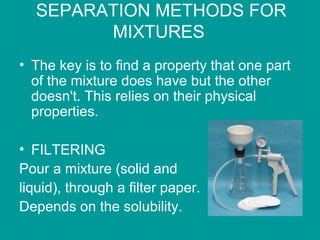Separation methods for mixtures
- 1. SEPARATION METHODS FOR MIXTURES
- 2. SEPARATION METHODS FOR MIXTURES • The key is to find a property that one part of the mixture does have but the other doesn't. This relies on their physical properties. • FILTERING Pour a mixture (solid and liquid), through a filter paper. Depends on the solubility.
- 3. SEPARATION METHODS FOR MIXTURES • CRYSTALLIZATION Slow formation of a solid from a warm solution that is cooled. Depends on the solubility.
- 4. DISTILLATION • Boil off and condense the more volatile component in a liquid mixture. Depends on volatility.
- 5. SEPARATION METHODS FOR MIXTURES • DECANTING Used to separate a liquid from an insoluble solid. The solid stays in the bottom.
- 6. CHROMATOGRAPHY Involves the separation of different dissolved substances as they travel through a material
- 7. SEPARATION METHODS FOR MIXTURES • CENTRIFUGATION Involves the use of the centrifugal force. More dense components migrate away. Solid particles remain on the bottom.
- 8. SEPARATION METHODS FOR MIXTURES • EVAPORATION Separation of a liquid and a soluble solid.
- 9. MAGNETISM A magnetically susceptible material is extracted from a mixture using a magnetic force.
- 10. MAGNETISM A magnetically susceptible material is extracted from a mixture using a magnetic force.










